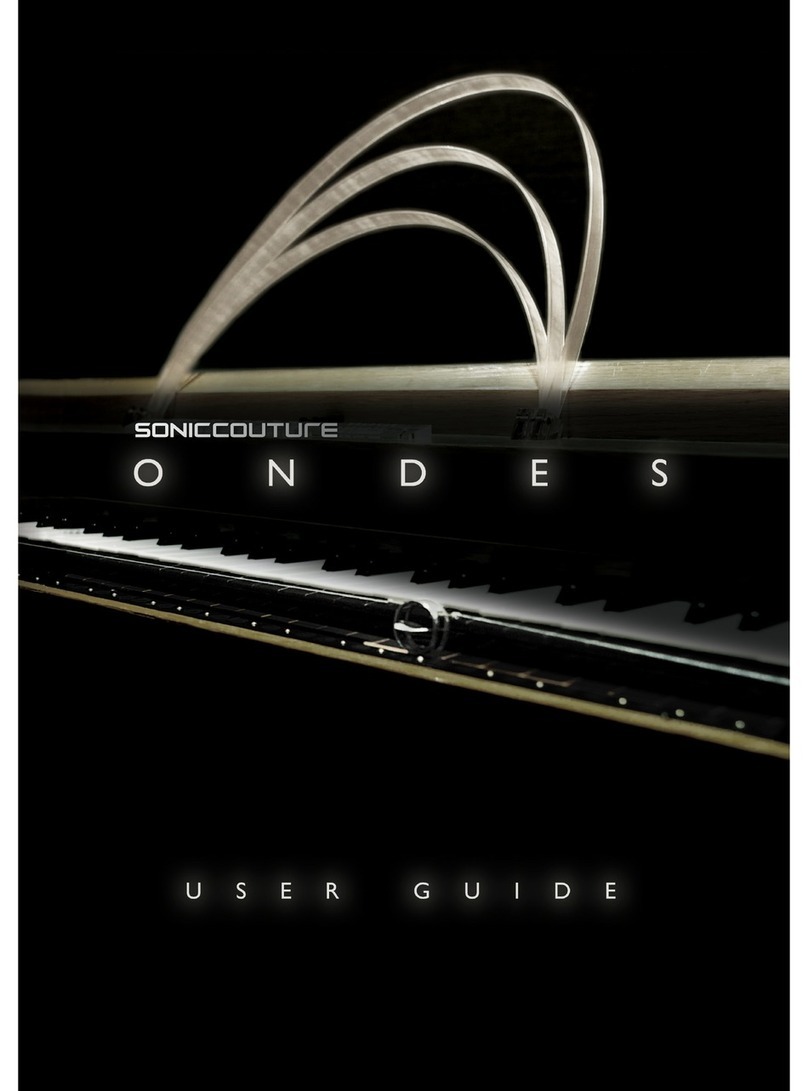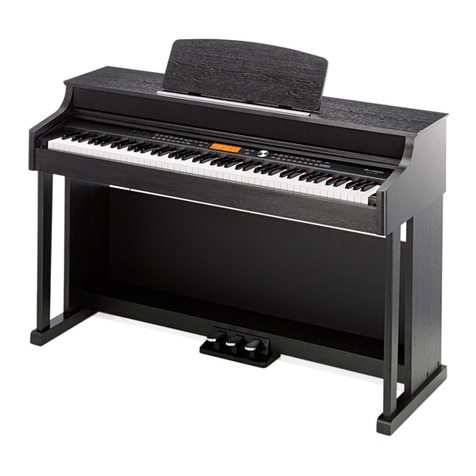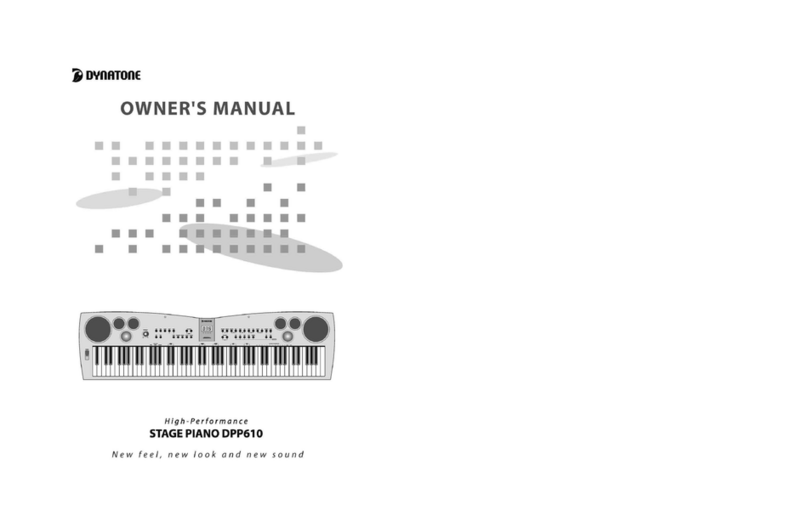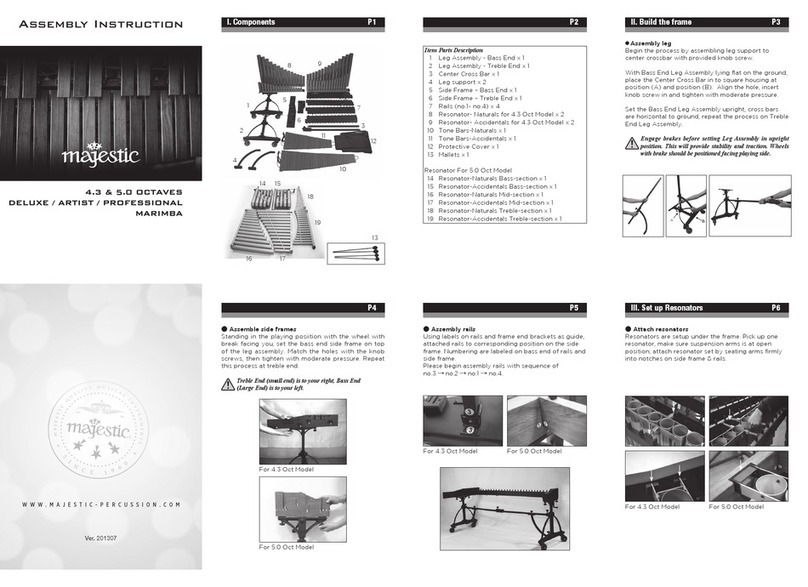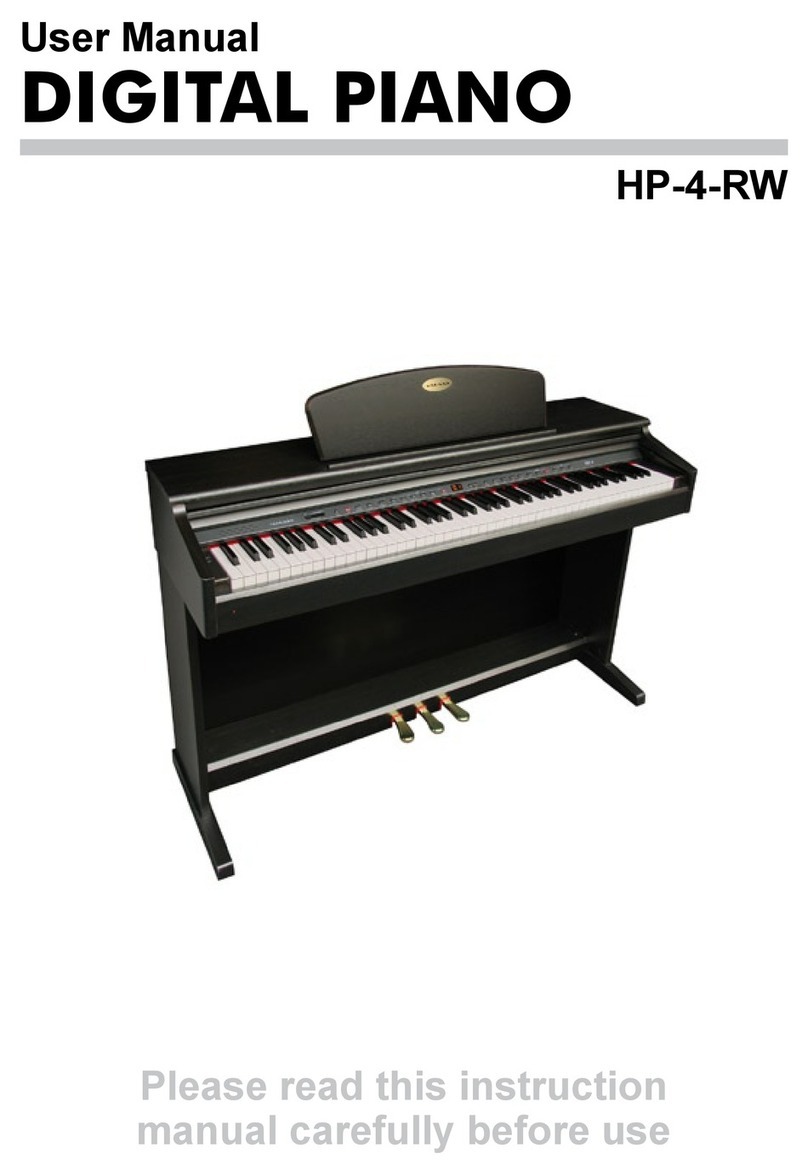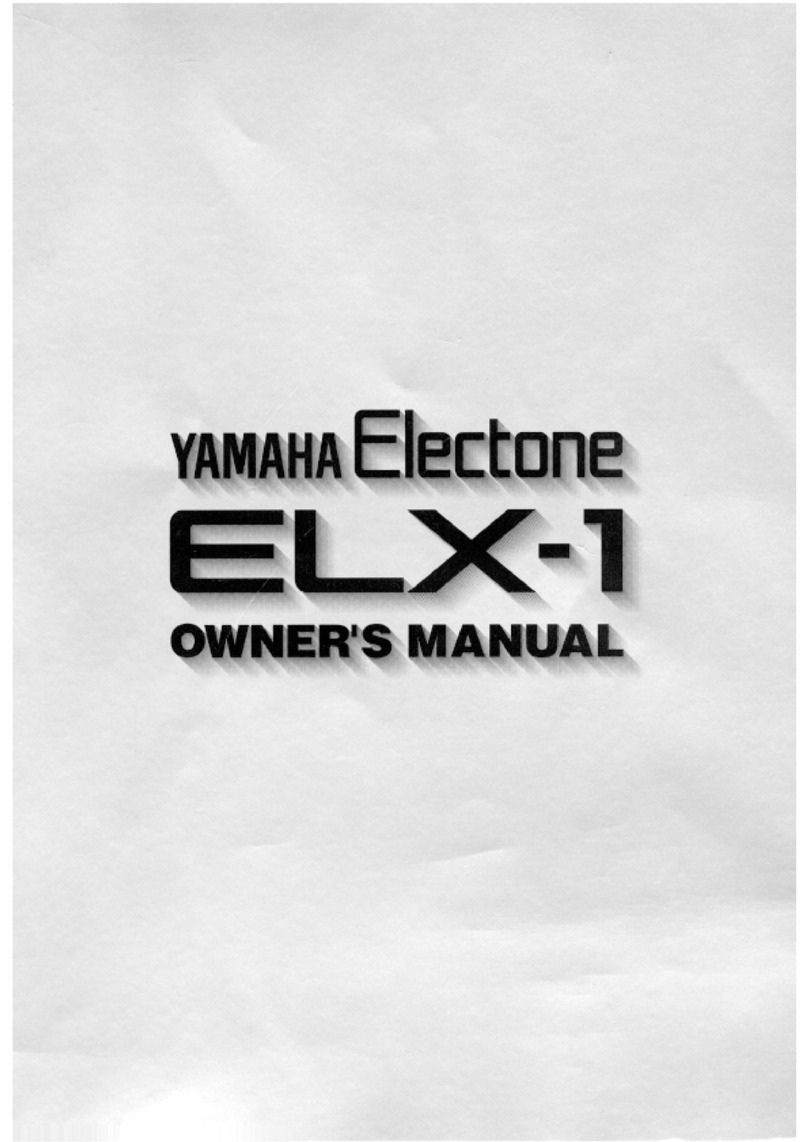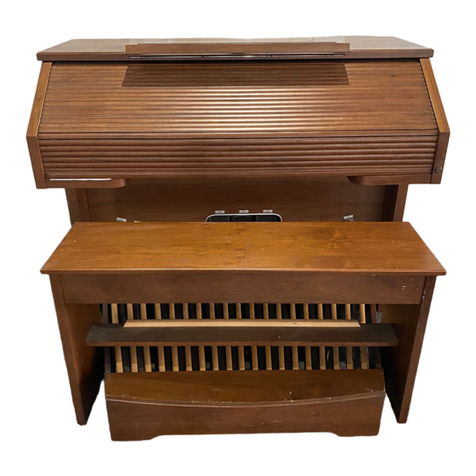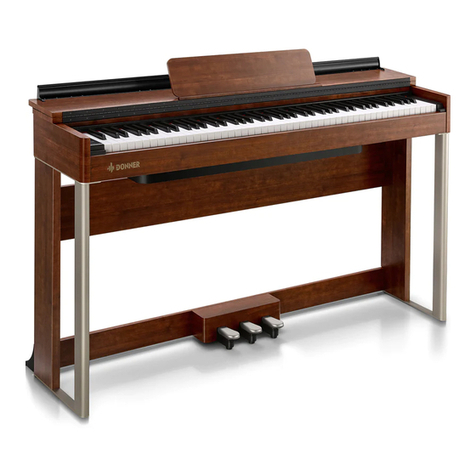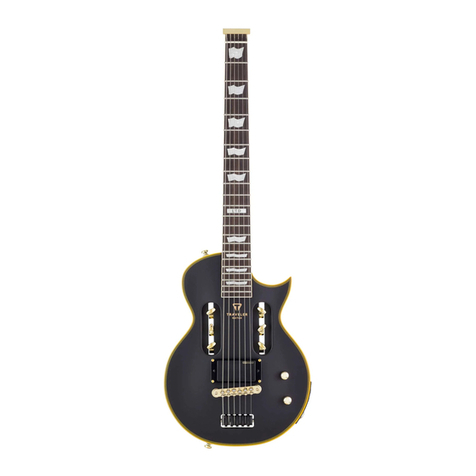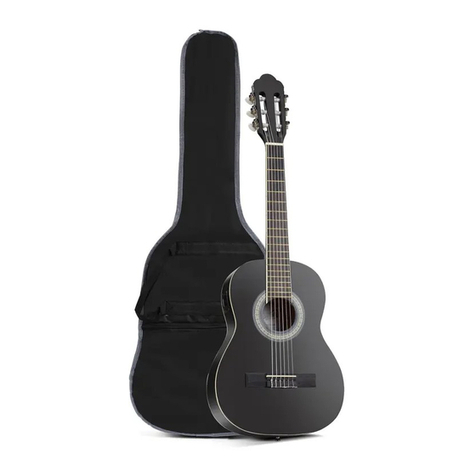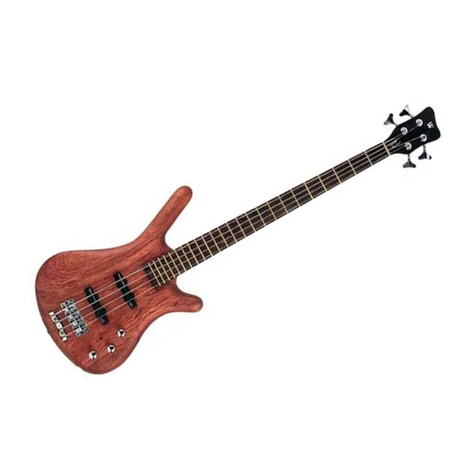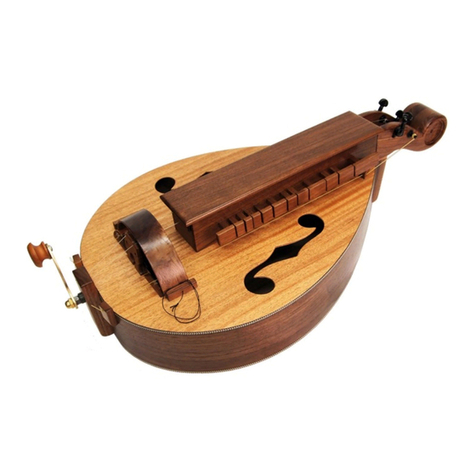RMI 368 User manual

lg£p^
mm-:
y&\
RMI
Electro
Piano
and
Harpsichord
368X
The
368X
is
another
out-of-this
world
innovation
from
RMI.
The
far
out
sounds
you
can
produce
with
this
instrument
are
limited
only
by
your
imagination.
Try
the
harpsichord,
the
organ
mode,
and
the
most
unearthly
true
piano
tone
you've
ever
heard.
Helping
you
to
blast
off
will
be
those
seven
additional
notes
at
the
top
and
a
powerful
first-stage
bass
boost.
The
whole
capsule
only
weighs
85
pounds,
and
since
you're
planning
to
travel,
solid
state
reliability
added
to
portability
will
mean
a
lot.
Hear
the
368X
at
your
space
age
music
dealer
and
expand
into
new
worlds
of
sound.
Rocky
Mount
Instruments,
Inc.
Macungie,
Pa.
18062

SPECIFICATIONS
RMI
ELECTRA-PIANO
&
HARPSICHORD
368X
SOUND
-
The
RMI
Electra-Piano
368X
produces
a
piano
sound
which
is
remarkably
authentic.
It
is
a
properly
scaled
piano
—
the
quality
and
intensity
of
the
notes
over
the
entire
keyboard
are
unusually
accurate
and
in
proper
relationship.
VERSATILITY
-
In
addition to
the
true
piano
sound,
this
instrument
has
a
fine
Harpsichord
sound
and
an
excellent
Lute
sound.
It
is
really
three
instruments
in
one.
PORTABILITY
-
The
RMI
Electra-Piano
is
truly
portable.
Its
chrome
legs
are
self-contained.
They
fold
out
for
fast
set-ups,
fold
flat
for
easy
carrying.
Total
weight
about
85
pounds.
DESIGN
—
Completely
solid
state
(all
transistors
-
no
tubes),
using
68
separate
tone
generators,
one
for
each
note
on
the
68
note
keyboard.
There
are
no
strings
or
bars
which
can
get
out
of
tune.
The
use
of
individual
tone
generators
for
each
note
is
more
expensive
than
other
methods,
but
does
three
things:
1.
Provides
true
piano
tone;
2.
Permits
performance
unmatched
by
any
other
system;
3.
Provides
a
high
degree
of
reliability.
KEYBOARD
CONSTRUCTION
-
The
individual
note
keys
are
completely
interchangeable
and
individually
adjustable.
The
action
is
quiet
-
it
has
all
the
excellent
characteristics
and
quality
associated
with
a
wood
action.
CONTROLS
-
Foot
control
unit
is
standard
equip
ment;
a
pedal
provides
full
range
expression
from
silence
to
full
output;
a
separate
pedal
produces
piano
sustain.
Rocker
type
on/off
switch
has
built-in
pilot
light.
The-Accenter
gives
a
percussive
attack to
the
harpsi
chord
or
lute
sound,
as
desired.
The
Organ
Mode
permits
all
stops
to
be
played
as
an
organ,
without
the
normal
percussive
decay.
SAMPLE
TONE
POSSIBILITIES
-
Electronic
Bass
-
The
keyboard
is
a
full
68
notes
extended
to
low
F,
thereby
providing the
useful
range
of
an
electronic
bass.
With
the
Lute
stop
depressed,
the
RMI
Electra-Piano
can be
used
to
provide
an
excellent
electronic
string
bass
accompaniment
"Honky-Tonk"
Piano
-
By
depressing
the
Piano
and
Harpsi
stops
an
authentic
"rinky-tink"
sound
can
be
achieved.
These
are
a
few.
There
are
many
other
unique
and
interesting
combinations
possible.
"BASS
BOOST'
CONTROL
-
Mounted
on
the
stop
panel
is
an
additional
sliding
control
for
the
bass
section.
This
makes
it
possible
to
increase
or
vary
the
amount
of
bass
power
at
will.
A
startling
effect
of
sudden
waves
of
bass
tones
can
be
achieved.
CONNECTIONS
-
Foot
control
has
two
plugs
at
the
end
of
suitable
cables
-
they
are
easily
plugged
into
jacks
under
the
piano
—
and
since
one
is
larger
than
the
other,
you
cannot
make
an
error
in
plugging
them
in.
T
line
cord
and
a
10'
shielded
cable
with
jack
for
plugging
the
piano
into
the
amplifier.
Both
are
permanently
attached.
An
AC
outlet
located
under
the
instrument
permits
switching
amplifier
on
and
off
with
the
RMI
Electra-Piano.
AMPLIFICATION
-
The
RMI
Electra-Piano
&
Harpsichord
368X
can
be
plugged
into
any
high
quality
music
amplifier
with
good
results.
For
the
best
results,
it
should
be
used
with
the
RMI-140A
amplifier.
This
is
a
special
purpose
amplifier,
with
its
own
separate
treble
system,
designed
to
bring
out
the
fantastic
upper
range
sound
capabilities
of
RMI
portable
keyboard
instruments.
MATERIALS
&
COLORS
-
The
RMI
Electra-Piano
is
covered
with
rich
black,
tough
material
which
resists
abrasion
and
stains.
The
tone
selector
panel
is
chrome
steel,
and
the
legs
chrome.
The
appearance
is
highly
distinctive
and
pleasing;
it
complements
the
great
sound.
DIMENSIONS
-
Height
Width
Depth
Open
35
3/4"
42
5/8"
23
3/8"
Closed
9
3/8"
42
5/8"
23
3/8"
POWER
-
105-125
volts,
60
cycles,
only
10
watts.
ACCESSORIES
-
Optional
accessories
include
extensions
for
the
legs
which
raise
the
unit
for
convenient
stand-up
playing.
Rocky
Mount
Instruments,
Inc.,
Sales
Office:
Macungie,
Pa.
18062,
Phone:
215/965-9801
Subsidiary
of
Allen
Organ
Company
COPYRIGHT
.61074

The
RMI
ELECTRA-PIANO
and
harpsichord
is
the
all
new
instrument
for
sound-thinking
combos
who
are
bothered
by
the
problems
of
piano
availability,
tone,
tuning,
and
transportation
that
limit
and
hamper
the
jobs
they
play.
These
problems
are
solved
by
the
RMI
ELECTRA-PIANO
and
harpsichord
—the
all-electronic
piano
that
delivers
the
truest
portable
piano
tone
available.
It's
the
one
with
no
strings
or
struck
bars
to
get
out
of
tune.
The
one
with
harpsichord
and
various
novelty-effect
stops
that
allow
you
to
change
your
sound
at
will.
And
the
littlest
big
feature
of
all:
its
weight
—
here
is
a
piano
that
only
weighs
about
80
pounds
including
its
slim,
modern,
self-contained
legs.
All
of
these
features,
plus
a
61
note
keyboard
and
expression-
sustain
pedal,
clearly
make
the
RMI
ELECTRA-PIANO
and
harpsichord
a
real
sound
investment
for
small
combos
on
the
move.
The
RMI
ELECTRA-PIANO
and
harpsichord
is
another
of
the
unique
sound
ideas
from
RMI
instruments.
Plug
into
one
at
your
nearest
progressive
music
store.
ROCKY
MOUNT
INSTRUMENTS,
INC.
Subsidiary
of
Allen
Organ
Company
MACUNGIE,PA.
18062

SPECIFICATIONS
RMI
ELECTRA-PIANO
&
harpsichord
SOUND-The
RMI
Electra-Piano
produces
an
acous
tical
piano
sound
which
is
remarkably
authentic.
It
is
a
properly
scaled
piano
—
the
quality
and
intensity
of
ths
notes
over
the
entire
keyboard
are
unusually
accurate
and
in
proper
relationship.
VERSATILITY
-
In
addition
to
the
true
piano
sound,
this
instrument
has
a
marvelous
Harpsichord
sound and
an
excellent
Lute
sound.
It
is
really
three
instruments
in
one.
PORTABILITY
-The
RMI
Electra-Piano
is
truly
porta
ble.
Its
chrome
legs
are
self-contained.
They
fold
out
for
fast
set-ups,
fold
flat
for
easy
carrying.
Total
weight
under
80
pounds.
DESIGN
-Completely
solid
state
(all
transistors
-
no
tubes),
using
61
separate
tone
generators,
one
for
each
note
on
the
61
note
keyboard.
There
are
no
strings
or
bars
which
can
get
out
of
tune.
The
use
of
individual
tone
generators
for
each
note
is
more
expensive
than
other
methods,
but
does
three
things:
1.
Provides
true
piano
tone;
2.
Permits
the
instrument
to
be
quickly
switched
from
Piano
to
Harpsichord,
to
Lute,
or
any
combination
of
these
sounds;
3.
Provides
a
high
degree
of
reliability.
CONSTRUCTION—The
keys
are
completely
inter
changeable
and
individually
adjustable.
The
action
is
quiet
—
it
has
all
the
excellent
characteristics
and
quality
associated
with
a
wood
action.
CONTROLS
—
Foot
control
unit
is
standard
equipment;
a
pedal
provides
full
range
expression
from
silence
to
full
output;
a
separate
pedal
produces
piano
sustain.
Rocker
type
on/off
switch
has
built-in
pilot
light.
TONE
SELECTORS
-
Piano
Lute
Piano
PP
Organ
Mode
Harpsi
Accenter
Harpsi
PP
The
Accenter
gives
a
percussive
attack
to
the
harpsi
chord
or
lute
sound,
as
desired.
The
Organ
Mode
permits
all
stops
to
be
played
as
an
organ,
without
the
normal
percussive
decay.
SAMPLE
TONE
POSSIBILITIES
-
Electronic
Bass
—
The
keyboard
is
a
full
61
notes
and
is
extended
to
include
additional
notes
at
both
the
bass
and
treble
ends.
When
the
Lute
stop
is
depressed, the
RMI
Electra-Piano
can
be
used
to
provide
an
excellent
electronic
string
bass
accompaniment.
"Honky-Tonk"
Piano
-
By
depressing
the
Piano
and
Harpsi
stops
an
authentic
"rinky-tink"
sound
can
be
achieved.
These
are
a
few.
There
are
many
other
unique
and
interesting
combinations
possible.
CONNECTIONS-Foot
control
has
two
plugs
at
the
end
of
suitable
cables
-
they
are
easily
plugged
into
jacks
under
the
piano
-
and
since
one
is
larger
than
the
other,
you
cannot
make
an
error
in
plugging
them
in.
7'
line
cord
and
a
10'
shielded
cable
with
jack
for
plugging
the
piano
into
the
amplifier.
Both
are
perma
nently
attached.
An
AC
outlet
located
under
the
instrument
permits
switching
amplifier
on
and
off
with
the
RMI
Electra-Piano.
AMPLIFICATION-The
RMI
Electra-Piano
can
be
plugged
into
any
high
quality
music
amplifier
with
good
results.
For
the
best
results,
it
should
be
used
with
the
RMI-140A
amplifier.
This
is
a
special
purpose
amplifier,
with
its
own
separate
treble
system,
designed
to
bring
out
the
fantastic
upper
range
sound
capabilities
of
RMI
portable
keyboard
instruments.
Another
advantage
of
the
RMI-140A
is
the
availability
of
the
RMI
Razer-a
super
articulator
which
provides
even
more
brilliance-to
the
highs.
MATERIALS
&
COLORS-The
RMI
Electra-Piano
is
covered
with
rich
blue
and
black,
tough
vinyl
material
which
resists
abrasion
and
stains.
The
tone
selector
panel
is
brushed
aluminum,
and
the
legs
chrome.
The
appear
ance
is
highly
distinctive
and
pleasing;
it
complements
the
great
sound.
^
DIMENSIONS-
Open
Closed
Width
Depth
42-5/8"
23-3/8"
42-5/8"
23-3/8"
POWER
-
105-125
volts,
60
cycles,
only
5
watts.
ACCESSORIES
-Optional
accessories
include
a
removable
music
rack,
and
extensions
for
the
legs
which
raise
the
unit
for
convenience
in
stand-up
playing.
ROCKY
MOUNT
INSTRUMENTS,
INC.,Sales
Office:
Macungie,
Pa.
18062,
Phone:
215/965-9801

JLlh
The
Model
368
ELECTRA
PIANO
&
HARPSICHORD
represents
the
second
generation
of
the
now
famous
RMI
300
series
portable
keyboards.
This
68
note
instrument
is
equipped
with
seven
stop
tablets
as
follows:
Piano,
Piano
PP,
Harpsichord,
Harpsichord
PP,
Lute,
Organ
Mode,
and
Accenter.
Two
additional
controls
appear
on
the
stop
board,
namely,
BASS
and
VOLUME
controls.
In
addition,
there
are
combination
foot
controlled
volume
and
sustain
pedals.
AUDIO
This
instrument
is
designed
to
be
operated
with
an
external
audio
system,
such
as
an
RMI
type
140
Amplifier.
It
should
be
remembered
that
the
tone
quality
and
power
will
be
limited
if
the
audio
system
does
not
have
good
performance
characteristics.
Very
few
amplifiers
on
the
market
today
have
the
brilliant
treble
response
so
necessary
for
producing
the
sound
of
a
Harp
sichord,
for
instance.
It
is in
this
area
of
bright,
treble
response
that
RMI
Amplifiers
excel.
An
amplifier
equipped
with
Reverb
provides
additional,
pleasing
effects.
Do
not
expect
satisfactory
results
if.you
connect
the
RMI
ELECTRA
PIANO
&
HARPSICHORD
to
a
BASS
type
musical
instrument
amplifier.
--
unless
bass
only
is
desired.
OPERATION
To
make
the
instrument
operational,
first
plug
the
AC
cord
into
a
110
V.,
60
cycle
receptacle.
It
will
be
noted
that
there
are
two
cords
and
plugs
connected
to
the
pedal
unit.
These
plugs
are
inserted
into
the
proper
receptacles
of
the
ELECTRA
PIANO,
and
it
is
hardly
possible
to
confuse
these
since
one
jack
is
larger
than
the other.
Next,
the
audio
wire
should
be
connected
to
the
input
of
the
aforementioned
audio
system,
and
the
amplifier
tone
and
volume
controls
set
for
the
desired
effect
-
with
the
volume
pedal
set
at
maximum.
Set
the
instrument's
Bass
control
at
the
mid
point
and
set the
instrument's
VOLUME
control
at
maximum.
The
instrument
VOLUME
CONTROL
is
s
convenience
feature
and
will
save
you
the
trouble
of
having
to
manipulate
the
amplifier
control,
depending
on
the
musical
effect
that
is
to
be
produced.
Now,.
you
may
increase
or
decrease
the
bass
according
to
your
taste
and
the
type
of
effect
that
you
desire
to
create.
PIANO
The
first
stop,
moving
from
left
to
right,
is,
of
course,
the
PIANO.
Depress
this
atop
and
set
the
volume
pedal
to
its
maximum*
Set
the
bass
control
at
the
desired
level.
Also
set
the
instrument's
volume
control
to
the
desired
point.
This
instrument
can
then
be
played
like
a
regular
piano
with
standard
sustain
pedal
techniques*
The
next
stop,
called
PIANO
PP,
is
essentially
the
same
but
softer.
**Also
Model
36
8X
MOUNT
IMQTRI
IMFNTQ
IMP
macungie,Pennsylvania
18O62
215/965-9801
IVIUUIN
I
UNO
I
nUIVIEZIN
I
O,
I
W
V*.
ASUBSIOIARY
OF
ALLEN
ORGAN
COMPANY
PLANT:
ROCKY
MOUNT,
N.C.
27801


RETAIL
PRICE
LIST
July
1,
1977
Suggested
List
Price
KEYBOARDS
Keyboard
Computer
KC-II
$4750.00
Electra
Piano
$
Harpsichord,
Model
368X
1195.00
AUDIO
SYSTEMS
Important
Note:
The
RMI
360
Amplifier
Line
is
designed
to
be
used
with
a
wide
variety
of
instruments.
Be
sure
to
select
the
proper
model
for
each
specific
instrument".
""
"
~
Model
360-G
High
Efficiency
Audio
System
895.00
(Includes
360
Amp
§
G180
Cabinet)
Designed
for
the
RMI
Electra
Piano,
guitars,
etc.
Model
360-B
Bass
Audio
System
825.00
(Includes
360
Amp
§
B
180
Cabinet)
•
For
applications
such
as
electric
bass,
etc.
Model
360-K
Flat
Response
Audio
System
895.00
(Includes
360
Amp
S
K180
Cabinet)
Suggested
for
use
when
there
is
a
specific
need
for
"flat
response11,
such
as
the
RMI
Keyboard
Computer
or
synthesizers*
360
Amp
Head
only
475.00
G180
Cabinet
only
500.00
B180
Cabinet
only
430.00
K180
Cabinet
only
-
flat
response
cabinet
-
for
high
volume
requirements,
use
G180
cabinet
500.00
Amp
Cover
-
fits
all
three
Amps
(2
pieces)
25.00
All
prices
and
specifications
subject
to
change
without
notice

SERVICE
INFORMATION
•■■'
'■■■"
-V.\,.
""r-
■■
' '
>'i
'>'■
ELEGTRA
PIANO
&
HARPSICHORD.
MODEL
368
&
MODEL
368X
,\
AND
RIANQS
&
ROCK-SI-CHORD
MODEL
668 &
MODEL
668X
ROCKY
MOUNT
INSTRUMENTS,
INC.

•<■*
NOTKll.IN;fTHE.E^CTRA
PIANO
;
j
SXmmGtf
&i>
CRACKMNG
NOISE
WHEN-PLAYING
AN
INSTRUMENT
i.
ACCOMPANIED
BY
RISE
OR
FALL
IN
VOLUME
OF.CERTAIN
NOTES
.■■:
.■••'
'.
■
•
. •
•;
..
••"..'
.•■.
-.■;;•
$UBJECT
3:
ORGAN
MODE
CIPHER
.
.-
-.::■..
:.;•-.i
SUBJECT
4:
CIPHER
WITH
"SUSTAIN"
PEDAL
SUBJECT'SS
:
A
SINGLE
NOTE
HAVING
A'
.'SNUBBED1!
OR
SHORT
SUSTAIN
SUB
JECT
6:
INSTR
UCTIONS
FOR
fTUNING
RMI
GENERATORS
SUBJECT
7:
INSTRUCTIONS
FOR
CURING
PROBLEM
OF
STICKING
-•■'■;-i
AND/OR
CLICKING
KEYS
ON
ELECTRrAPIANOl
SCHEMATICS
AND
PICTORMATIC
LAYOUT
•
»
.
'•
!
•
,

SUBJECT
1:
FIXING
A
"DEAD
NOTEffOEM
THE
ELECTRA
PIANO
Before'tioirig
any
te§tiri&#
'make
-a
i&6roughAHsuarvcHfifcklcJ
make
all
components
are
in
proper
physical
location
without
shorted
leads,
etc.
All
components
for
one
pitch
are
in
a
straight
line
from
front
to
back,
as
shown*
bn
the
pidtormsitic:
l&ydiit.'
^The
dir&iit
showii
1£
'repeated
f£x*
-e^Qh
^
pitch.
'>
*U/
";
'-OV
/;?.!.*/.'.»'
•!'
>
1.
;/
•
/
■";
r,'-":
-^V
'
r
">//.,/.
Trouble
Shooting
a
Dead
Key
1.
Depress
Piano
stop.
//
?
>
^/t
L
K
.
:r
;
2.
Make
sure
key
contact
is
clean
and
"making".
3.
Attach
a
clip
lead
in
series
with
a
220
ohm
resistor
to
the
B+
terminal
at
the
right
end
of
the
generator
board.
Touch
the
T
:
other
end
of
the
clip
lead
to/pbint
MD'/.
It
-the
oscillator
plays,
,
you
have
isolated-the
problem
to
the
keying
clrcult~(pric>ceed
to~
"8M
below).
But,
if
the
oscillator
is
still
dead
when
keyed
at
!D">
prodeedais
follows:'
/
rfv
\
,:.
v
?.,'•■
4.
With
B+
applied
to
point
lfD"
through
a
220
ohm
resistor,
measure
)the
DC
voltage
at
point
HDn>
A
zero
reading
indicates
a
shorted
>
keying
capacitor;
C7*.
A
very
low.
reading
indicates
a
shorted
blocking
capacitor
C8#
5.
Take
a
low
ohms
scale
resistance
reading
across
points
"A11
to
"B".
A
zero
reading
indicates
a
shorted
tuning
capacitor
-
C9.
•■:
}..
^
<f
/
,
•"
.'•';
x:-:>.\".»:I
:
-'
-
Av
\\yy-
6.
Take
a
low
ohms
scale
resistance
reading
between
points
flCfl
and
"A"
and
then
lfCn
and
lfB".
This
measures
each
side
of
the
oscillator
coil.
Both
readings
should
be
identical.
If
they
are
not,
a
defective
coil
is
indicated.
7.
Take
a
resistance
reading
across
resistor
R17.
Reverse
the
leads
and
measure
again.
The
one
reading
should
be
approximately
ten
times
higher
than
the
other.
If
both
readings
are
similar,
this
indicates
a
defective
transistor.
8. If
in
3
above,
the
oscillator
operates
when
keyed
at
!lDfl,
then
proceed
as
follows:
9#
With
a
clip
lead,
short
across
capacitor
C5,
and
depress
the
key.
If
the
oscillator
now
plays,
this
indicates
an
open
capacitor.

7r<
^^
j
gK
it
^
iit
il;
-
take
a
^isMft^
te^di^
i
n>eas:ui?6
^aiii^
>
A,;zerp
reading
bail*
dir
>:.:;
sHdrt^d;dic?g&
^iiicfe
vrtiiild
daEtfse
a
dead
12.
Tiake
a
resistance
reading
across
capacitor
C6*
A
zero
reading
j
f
r
^uldiindiGflttei
a
isjip^if
/j
;i°:
^-
•"
'i
?-{"v.;r;(.-.
••;"•'•.
...;;
•/
.;
•■■•,
•!f--»'^,?fA
13;
If
all
the
stbOyg
dhecfc
but
tiOfrraallyr
replace
the tr
P
N0ISE
WHM^LAY3/NGAN
^^
CERTAIN
NOTES
Tjiis
cpriditipil
e^fti
fee^ici^u^ed
by
k
cdicj
-9pld®h
JQiritflia
the^^Liidio
bliss
bar'^
line
w;hich
riiris
the
length
of
the
tone
generator,
and
is
located
just
behind
hfe
bddiil^td^'tiiife;
^dii
thfe
scheiiiktic^ thi?
^
d^ll^d^e
SPLIT
C3ROUND
*ftse
hd^ethkttH^^eaxe
sesifetars
sold&red
ih;at
V^Hpus^ppintS'SlQng:1
*
this
line.
If
the
above
condition
occurs,
carefully
chepk
each
sp>ide#
-
\:
connection
along
this
line
and
resolder
where
necessary*
Of
course,
the
above
procedure
assumes
that
the
strtiplifier^fepBiifcerSystem
.-•.■■
-.r-.
.-
If
a
certain
pitch
sounds
continuously
when
the
Organ
Mode
stop is
used,
the
trouble
is
usually
caused
by
a
defective
diode*
CI17.
The
location
of
this
diode
is
shown
on
the
pictprmatic
layout
drawing.
When
replacing
this
11^
•-.
ffljie
^^.^(^^
pypyities
i??to^e
bass
^^
^i^
som
^hbrs.j^
'9,
fla>?(
in
the;
i
f
4iei
^pM^Pv
^
Gp^i^qweni^
^rhen^MC^j^je^.c^
j^Sjpbi^rved,
it
is
necessary
to
lower
the
setting
of
the
bass
control
to
the
point
where
no
distortion
occurs.

SUBJECT
4;
CIPHER
WITH
"SUSTAIN"
PEDAL
If
a
certain
note
sounds
continuously
only
while
the
Sustain
pedal
is
9ir^ransIstbrV
ffie^ocatidri
of
WhichI^rinudi^aife6d
on
the
pfdtor-'
J
rnatic
layout
drawings
Apparently
in
some
environments
a
conductive
>
appears
eta
tfte
surface
\o$
theI
trfatiSiator^heret^Ke
leaftfe
lpstici;';>,U^e
ai$^gllScrewdriver/ior;
•sim^rlPPinted
object,
and
scrape
along
the
surface
of
the
plastic,
between
the
center
#nd
Bid*
leacl^U^
i,s
t
when
yoto^rthig;
otherwise^i;the
;t^a«isistorpa*i^
bej
buried
<?ut
accidentally
connec1£ng>^\^^
dp^a
.riot
curie
the
condition,
only
then
replace
the
transistor.
Another
cause
for
this
condition
is
the
2
ml&rfblQptrolj^c;
capacitor,
C6,
the
location
of
which
is
also
shown
on
the
pictormatic
diagram.
Observe
the£c&£*ect
pblfeirity;
riiarkings,
iU
8?epl&fcing>
this
<?ot?&pqiitent•
^Vskv
for?
5
Electra
Piano
Capacitor
C6.
The
circuit
shown
on
th^
pictormatic
layout
is
duplicated
for
each
pitch.
^a*riife"k^pa^&it^t\>_i^;
^:^t|c>r%tj&cj
cVDrtcK^dtoM.
(\yd3i
;csius£ia\
dead
note?
p^e^§ure
£tGiipss-th6'
c&p^ifbr
wifR
in
A
"SNUBBED1!
"^nut)bed"f
or.pxtra
sfeortiovprtjthe
entice
keybipard,
the
problem
is
most
probably
due
to
leakage
in
one
of
^i
>procedj^%will
hQlp>ypurto
locatq
whiohiQf
thg;
is
at
1.
Put
one
of
the
tone
stops
down;
for
example,
Lute.
3.
Wedge
the
lowest
note
on
the
HeyfeehaydL^pii
^Uf^^pii/^)^
even
after
the
souncj
of the
note
dies
away.
4*
Hold
the
sustain
pedal
on.
5.
Start
at
the
high
end
of
the
keyboard
and
play
one
note
at
a
time,
listening
for
the
length
o$/#*e'^taip.,j.The
^e
with
^.dpfe
diode
will
have
a
sustain
T^tibff^W5brt(e^:c^4ir
ifi&:other
notes."
SUBJECT
6:
INSTRUC^0>OR
Tti^
y&6
*uiiihg
ctf
ah{
Rklins^m^tit^cani^
aec^mpii^hod
in
les?
thg^
pijih^ixr
%^^^
-pience'in
tuj^ijg?^
*
"i$$
;
&^^^
aid
of
sjbiViObpe
Who.
is
^ydlifijed.
IJpweyep,
^
ihe
fbdldwjng
^sho
%

I
W^r
—^
1
(continued)
'
'
I
Ajctupilly,
there
i^nq
mystery
about
tuning,
and
it
does
not
require
a,
I
musical
ear,
as
that
term
is
understood.
It
does
require,
however,
ait
■
ear
which
can
hear
the
wave
beats
between
two
frequencies
of
very
he
3^m^j3itph
|
Use^^
the
"Organ'
MoBe11^
and
ffPiinbfl
stops
for
tuning
purposes,
"
,
,.
'To
make
a"
change
iii
frequency
(tuning),1
iurri
tiie
'potentiometer
ty'^e'
}^'%yi
■
tuning
control
either
clockwise
(sharp)
or
counterclockwise
(flal)^"'1*'
A*°
I
depending
upon
which,
w^y
it
is
desire.d
to
shift
the
pitch.
If
a.given
nqtQ.
I
cannot
be
brought
into
proper
pitch
fryacljus^m
it
ip
nepessary
to
carry
put
the
following
procedure:
.
;.
.
f
.
Adding
capacity
tq
any.given
tuned
circuit
will^lower
th^freguencyj
"Oix
^ii^raelj^e^pvlpg
capacity
from
any
rgiyen
tiuied
circuit
will
raise
.its
■
freque^ncy^
^e
^mallest
of
the
tuning;
jc^tpacitbrs^
C§,"
sfipuH
be'
phpsen
"~"'
|
as
/the
ope
tochange
*
in
other
words,
if
a
generator
cannot
be
maie
sharp
enough
;With
the^controj,
it
will
be
necessary
to
reduce
the
capacity--
\.
u
re,moyQ
one
of
the
§mall
value
tiinihg
'capacitors
.aiid
replace
it
'with
the
'
I
next
smaller
sxze>
■
ft
%s
neqessjary'
to
liaye
some
type
of
pitch
standard
pxi
reference
-!r
J&fr
tf}h
|
'
tuiielf
piano/
etectrqnic
clevice
such;
as,vtlie
Conn,
Strbboturier{or
PeteT^soii^
Tuner,
or
"A"
tuning
fork
for
those
who
can
set
a'
teinpe^ameiit%y
feaR
'l
■
Several
paodels
of
audio
ostcillatof
reference
,ctevices
for
tuning
pu^ppse^s
|
Tq^b
^ese^^^^si^qL^ly^
zero
beat
the'
ftiytt^
unit.
I
^
E^c^tt^
tu^ier
cpny^nieritly
sq
you
hay^
eas^.
access
to
the
seij^ctbr
s^
a
patch
cord
between
the
tuiier
arid
the
output
pf
^
If
you
wish
to
listen
to
the
sound
as
well
as
see
the
strobe
paitern^
use
an
?tRCA
audio
tfYfl
connector
at
the
generator
output,
trs
First
set the
tuner
gain
control
to
produce
the
best
pattern
contrast*
^
generator can
then
be
tuned
in
the
usual
way
changing
the
tuning
adjustment
to
produce
&
stationary
pattern
on
the
strobe
disc.
The
tone
selector
knob
is
reset,
of
course,
for
each
different
tone
measured.

>'
Vv;iir;:-o-:>
the
pointer
to
stop
the
pattern
in
case
movement
is
noted.
Instead
of
tuning
successive
notes
in
each
octave,
^<We
»tUfie£s
prefer
to
use
this
method.
First
tune
the
ffCfsff
in
all.Qctavep
with
your
selector
switch
set
atk*#*ra
tK^n^r^e^Vith^if
the
^'s^
&£
•
^iAs"trietKbd
reduces
the
nujnber
qf
tone
selector
switch
settings;,
and
speerds
the
tuning
operatibi^
cppie
The
itfeffiok
pXrSe^fing
Te^j>e
tuning
peVices'
'
"
"'
One
note,
say
A3
(A
abov6
miSdler
6)
is'chosen
to
Wt^
note
is
tuned
tq?
a
s|;andar(|
spurqe,
usually
440
cycles,
whiph
might
cpp
from
a\tunijiig'^wfe*!r!af^ffier^^tum6xit,
or
an
el^hirohiH
si^nditd^
Th
x^xt;sie|^
$ttb
^oundtherl;3
ancf
^53;''
ThW
:^t4i^lT^
^loui^h;J
^
toe\the
E3,'&^%
The'^at
'
*
occurs.'tietween
.^e/to^^
^a^r&piiii
of
the
,A3
^nA
tl\e
fotitth
^r^onic
of
the
E3f
F^prjcorrect
turiing,
tfiis'jbeat
freque^
ohean^
qrie-
quax^er:'beat's
p^r
'second
or^ i'6
beats
in
ife
Seconds.
^
Th^actualjfreque'ncy
of
the
third
harmonic
of
A3
is
1320
cycles.
A
beat
frequency
bif
one
and1
.^
......
..
».
•
.
.
.
..
.
,
.
■
i
,
^fi^3|ifi^hen
soun^ea;^
^is
larval
U
ajjr^ti^j.pajL
fl£t&^/
The
beat
noie
occurV
between
the
thirtfharpaoiiic
oi
tlie
^3
iari'd
tKi
Second
harmonic
of
the
B3,
and
is
about
one
and
one-quarter
beats
per1
second.
Again,
two
different
frequencies
of
B3
v?pl
g^ye
the.
cori;ect.beat*
As
before,
the
lower
or
flattest
of
the
two
mus£&e:^
.until
finally
on
#ie
12th
step,
acheck
is
agairt
paade
on
A3,
this
time
with
D3.
.[]'r
A
list
of't^
given.
ff^e'last^t^P^
D3i'
^nd'
A
3
.rdsuits
in
a'beat
thiat
is
slcrtv
eijoiugh
to
be
coulrf-etfi
tkd
^uiiiiig'
iem^eramQn^^
'To
tune
the
rest
of
1:he
;generat6V,
ofitav^^yrei'theh'
n^?o'5zkro'lJ6at^ti?
'f
'
;
'
j
All
of
the
following
notes
are
t^o
be
taken
from
the
third
octave
(from
middle
C

T7=T7r"~Tr~~"""^
(continued)
1.
Use
Piano
and
Organ
Mode
Stops.
2«
Set
A
to
tuning
fork
or
other
standard
(440
cycles).
3.
Sound
A
and
E
tuning
E
about
1-1/4
cycle
under
or
flat.
4.
Sound
E
and
B
tuning
B
about
1-1/4
cycle
under
or
flat.
5.
Sound
B
and
F#
tuning
F#
about
1-1/4^ycle-wndep
or
flat.
;v
6.
Sound
F#
and
C#
tuning
C#^
abo^t'1-1/4;
cycle
under
or
flat.
;„-
.
r,
"7.;'
So^iid
^
eycle
und^r
or
flat.
,
8^
Sound
G#
and
D#
%upingj}tt
abdut
;^
or
flat,
9.
StfiiilclJ6#
apd
A'$
funfng^#
a¥ojut:
1-1/4
cycle
iind^r
or
flat.
10.
Sourid
A#
and
F-tiJHin^Ti?
abQiit
1-1/4
cycle
uhdef*
or
flat.*
../.
11
#
Sound
]F?Lnd
C
turfiti^jC.
4b<?Mi.J.S'X/,4
5ycle
up.d^r
oV.
flat.*-
v^
12.
Sound
C
and
d
tuning
G^boiit
1-1/4
cycle
under
or
flat*
y
13.
Sound
G
and
D
tuning
{^about
1-1/4
cycle
under
or
flat.
14.
Sound
D
and
A
tunMg
about
1-1/4
cycle
under
or
flat.
*r
Ifjthe
A
does
not
automatically
seem
approximately
right
in-relation
to
the~D,
then
it
is
necessary
to
back
up
so
as
to
even
out
the
temperament.
If
the
A
is
too
flat,
it
shows
that
the
previous
notes
have
been
tuned
too
flat,
and
it
is
necessary
to
"slow11
their
beat.
In
listening,
car$
must
b$
taken
that
one
t&lis^^^^
due
to
the
higher:
har.monics*.
Qtlierwise,
^
"fal^e1'.^effect
ypXf.
be.
obtained;due
to
the
/.<*—^-"
^y-'^tb^gl?6|ihte
upper
harmonics*'
f,:
::
.
;
.
••»■!•>

SUBJECT
7:
INSTRUCTIONS
FOR
CURING
PROBLEM
OF
STICKING
~~T,
AjND/OR
CLICKING;
KEYSy
QN.
ELECTRA
PlANO
;:
:
I:
1*
Open
lid
by
removing
two
thumb
screws
on
Jbottorn
of
instrument,.
1.
Remove
black
keyboard
facer
^trip
by
removing
the
two
round
head
slotted<rs'crewk
from
front
bottom
dif
instrument;
3#
Remove
keybed
by
removing
the
ten
phillips
head
screws
from
bottom
of
instrument*
4*
Install
metal
washers
as
shims
between
metal
limiting
rail
(a)
and
wood
keybed
(B)t
using
one
washer
(C)
behind
each
screw
(D),
Caution
-
remove
one
screw
and
shim
one
portion
of
keybed
at
a
time,
5*
Reinstall
keybed
and
check
contact
adjustment*
6#
Reinstall
facer
strip*
7*
Install
thumb
screws*
NOT
APPLICABLE
TO
MODEL
368X
OR
MODEL
668X

^
•v--&;vi\--!:
^/Wr-)!'
j
^Hi'l
Ci
>M—
V-.^^.,...^
,
..^
..

■
m ■
m
.••-
--.I.'..
.
■..
..•*
■'U

TONE
:
amd
STOP
SECTtOU
BOOST
CIRCUIT
VOLUME
COV1TR0U
SGOO
EXPRESSOM
PEDAL
CIRCUIT
ALLEN
ORGAN
C0.r
Ei-H^T.^rA
F/iNC
y.ZZZL.
3i
2
TOWS
ChAN2£R
C
Ki^OCK
C'^.C

"
'i
PICTORMATIC
LAYOUT
r.RMI
368
a
668
OSCILLATOR
a
KEYING
CIRCUIT
SPLIT
GROUND
BUS
LI
CIO
RI8
03
R16 5-
RI5
C8
RI7
ORGAN
MODE
•
BUS
' •
RfO"
;cr&
SINGLE
PITCH
EXAMPLE
.R7-
;6rgan
TCR
"GND.
:R6
R5
CR6:
:1
«
STOP
SWITCH-GROUND
w
1
BUS
(STOPHfJFF)
KEY
,NPUT
SUSTAIN
PEDAL
BUS
;C
This manual suits for next models
3
Table of contents
